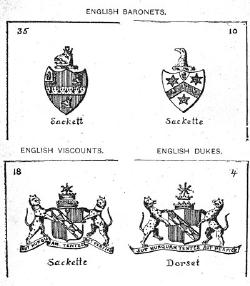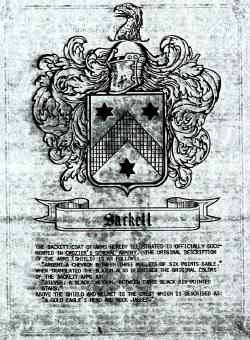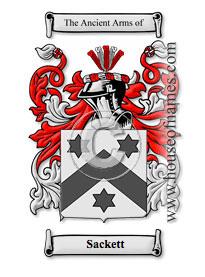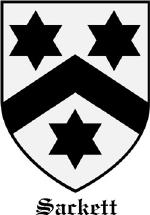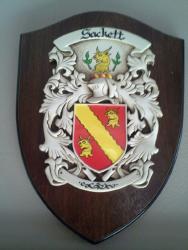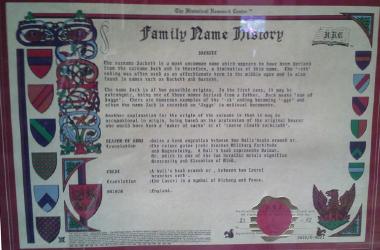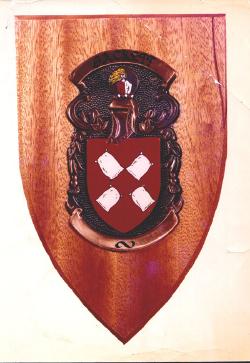Sackett coats of arms and crests
Several coats of arms and crests for members of the Sackett family have been claimed. All are entirely bogus. No individual Sackett has ever been entitled to an achievement of arms. And there is no such thing as a coat of arms for a family name.
Some designs are ingenious, with apparently persuasive descriptions. As novelty items, they are not without interest; they should not, however, be taken seriously.
The publishing of fake or counterfeit coats of arms is nothing new. The most repeated so-called Sackett arms, comprising a chevron and three six-pointed stars, began life in a book published in 1815. The arms were stated to have belonged to a Sir William Sackett who had received a baronetcy in 1673.
Research reveals that the real baronet was Sir William Blacket. The Sackett claim was a deliberate forgery.
Weygant's Family Record (1897)
Charles Weygant, in Issue 1 (January 1897) of his publication, The Family Record, included reference to an untitled (but dated 1815) "rare old book" which had belonged to Dr John H Sackett (1789–1822), surgeon of the US Army. By the name on a flyleaf, the book had previously belonged to a British officer, Major General Wilson.
Believing the book to be reliable, Weygant copied the following illustrations and accompanying references:
Plate 35.—"Sackett, John, Leeds and Somerbypark, Lincoln, Sept. 25, 1813."
Plate 10.—"Sackett, William, Matson, Northumberland, December 12, 1673."
Plate 18.—"Charles Sackville Germain, Viscount Sackville and Baron Bolebrooke, in Surrey."
Plate 4.—"George-John-Frederick Sackville, Duke of Dorset; Earl of Dorset and Middlesex; Baron Buckhurst and Baron Cranfield."
Weygant gives the names of the compilers: J. Mathison, A.W.Mason, and J.S.Kingston, of the Secretary's Office, East India House. From this, and the date, it would appear that the "rare old book" was The East India Register for 1815. A copy of this publication has not been found but it was advertised in the Quarterly Review and The New Monthly Magazine, literary and political periodicals of the time, at a price of 7s 6d.
The items referred to as Plate 18 and Plate 4 may be quickly dismissed as irrelevant as there is no link between the Sackville and Sackett families (it may be assumed that "Sackette" in Plate 18 is a publisher's error for "Sackville", the arms illustrated being almost identical to those attributed to Sackville, Earl of Dorset, in Plate 4).
The "John Sackett of Leeds and Somerbypark, Lincoln" of Plate 35 would appear to have been, at first glance, a transcription error on the part of the compilers. More realistically, it is a deliberate deception. No John Sackett, or any other Sackett, has achieved the rank of baronet, and none is found in the records as "of Leeds and Somerbypark" or of either place. The History of Parliament1 shows that the reference is to Sir John Beckett, 1st Bt., of Leeds, Yorkshire, and Somerby Park, Lincolnshire, who received a baronetcy in 1813 as a reward for his services as a magistrate in Leeds and Lincolnshire. Debrett's Peerage2 has "Beckett, John, Leeds, co. York, Sept. 25, 1813."
The reference to William Sackett of Matson, Northumberland, is a similar deception, the correct reference, according to Debrett's Peerage, being "Blacket, William, Matson, Northumberland, Dec. 12, 1673".
Crozier's General Armory (1904)
Another early reference to a Sackett coat of arms is found in Crozier's General Armory, published in New York in 1904. The Sackett entries in this book would appear to have had their genesis in Weygant's 1897 Family Record.
An entitlement to bear a coat of arms would appear to have been claimed by brothers Charles Woodward Sackett (1845–1917) and Colonel Henry Woodward Sackett (1853–1929), citing their descent from Simon Sackett (the colonist) and John Sackett of Northampton (1632–1719), Simon's son. There is no evidence to support a claim that Simon Sackett had an entitlement to arms.
Several similarities between Weygant's 1897 Family Record and Crozier's 1904 General Armory suggest that Crozier took his information from Weygant's publication. Further clues suggest that it would have been Charles and Henry Sackett who submitted the information to Crozier in order, presumably, to document their claim to the arms:
- Crozier repeats Weygant's incorrect supposition that the Sacketts originated in Ely, Cambridgeshire (instead of Thanet, Kent);
- Crozier's description of the arms claimed as belonging to the four named Sacketts ("a chevron between three mullets of six points"; "an eagle's head and neck erased") matches exactly those depicted as Plate 10 in Weygant, now shown to have belonged to William Blacket;
- the Sackett line (III) in Weygant's May 1897 issue of the Family Record is that from John Sackett of Northampton to the brothers Charles Woodward and Henry Woodward Sackett, suggesting that the brothers had been in contact with Weygant between January and May 1897;
- the motto attributed by Crozier to John Sackett of Northampton (and the other three named Sacketts), "Aut nunquam tentés, aut perfice" (Either do not attempt, or complete), appears in Weygant and is that of Sackville, Earl and Duke of Dorset. (The rendering of "tentes" with an acute accent also betrays Crozier's lack of credibility, there being no accents in Latin.)
Matthews' American Armoury (1907)
An entry for Colonel Henry Woodward Sackett, presumably submitted by him, and repeating the claim to a right to the arms, appeared in Matthews' American Armoury and Blue Book4, published in 1907:
Col. Henry Woodward Sackett, of New York City (Third son of Dr. Solon Philo Sackett, 1818–93, of Ithaca, N.Y., m Lovedy K. Woodward; son of Philo, 1788–1863; son of Major Buel, 1763–1840; son of Benjamin, b 1736; son of Jonathan, 1696–1773; son of William, 1662–1700; son of John, 1632–1719, of Northampton, Mass; son of Simon Sackett, from Isle of Ely, Cambridgeshire, Eng., b 1585, to New Eng., 1630).
Born at Enfield, N.Y., Aug. 31, 1853; Grad. Cornell Univ., 1875; admtd. to the Bar, 1879; apptd. A. de-C., Governor Black's Staff N.Y.S., 1896; Pres. of Cornell Univ. Club, N.Y. in 1897–98; Secretary Hudson-Fulton Celebration Commission, 1906; m Nov. 17, 1886, Elizabeth Titus; Senior member of law firm of Sackett, Chapman & Stevens.
Arms – Argent, a chevron between three mullets of six points sable.
Crest – An eagle's head and neck, erased, or.
Motto – Aut nunquam tentes, aut perfice.
Residences – 515 Madison Av., N.Y. City; and Mamaroneck, Westchester Co., N.Y. Clubs – University, Cornell University, Republican, National Arts, Hardware, New York Bar Association, City, Phi Beta Kappa Alumni, St. Nicholas.
Societies – Sons of the American Revolution, Order of Founders and Patriots of America, St. George's.
Weygant's The Sacketts of America (1907)
It is interesting that, when Charles Weygant came to compile his 1907 book, The Sacketts of America, he did not repeat the data about Sackett coats of arms from his 1897 Family Record, save for references to Sackville (which, having no information on the English roots of the Sacketts, he believed to be a variation of the name). The only illustration of arms used in the book was that of the arms of Thomas Sackville, Earl of Dorset.
The omission of the alleged Sackett arms may suggest that Weygant had come to doubt the credibility of the "rare old book" from East India House. Tellingly, he did not record Henry Woodward Sackett's claim to the arms, despite providing a detailed biographical sketch for him, and despite Henry's brother Charles having been one of Weygant's main contributors (he is acknowledged in Weygant's Introductory Statement).
The World Book of Sacketts (c 1960s)
A copy of The World Book of Sacketts was bought out of curiosity in about the 1960s by Edgar Cyril Sackett (1902–1993) in response to a Readers Digest offer.
The book included "The Sackett International Registry" compiled at a cost of "thousands of dollars and months of effort". This comprised a listing of Sackett names and addresses culled from telephone directories, electoral rolls, etc. It did suggest reasonably accurate estimates of the numbers of Sacketts in Great Britain, the United States, Canada, and Australia. Minimal information was given that Simon Sackett had immigrated to North America.
Also included was an illustration of "the Sackett coat of arms" as "officially documented in Crozier's General Armory", repeating the heraldic description and adding an explanation of the terms.
The arms are not attributed to a named Sackett and, in describing them as "the Sackett coat of arms", the publishers are propounding the myth that arms can belong to a family name.
More recent arms and crests
The Sackett coat of arms offered for sale by HouseofNames.com is accompanied by historical details which, in their almost complete inaccuracy, are testament to the bogus nature of the product.
The statement that the Sacketts were "first found in Worcestershire where they were anciently seated as Lords of the Manor" is wrong in every particular: no early Sacketts were in that county, and none has ever been a Lord of the Manor, there or anywhere else.
Equally wrong is the statement that 17th-century Sackett "migrants settled in the eastern seaboard from Newfoundland, to Maine, to Virginia, the Carolinas, and to the islands": none settled in any of these places. Another online store, "Coat of Arms Store", offering for sale the same coat of arms states, without qualification, that Sackett was a German regional name from Saxony. There is no evidence to support such a notion.
This shield is a modern-day simplified representation of the familiar "chevron between three mullets of six points sable", pirated by the compilers of The East India Register in 1815 from the coat of arms of Sir William Blacket.
The bulls' heads coat of arms
The following coat of arms and accompanying "Family Name History" were received as a gift by Association member Dick Sackett.
This item departs from the chevron and stars theme. Its provenance is not known: it could be a copy of a genuine coat of arms, or it could be a new creation.
The name history suggests that Sackett is a diminutive of "Sack", the -ett ending being used as an affectionate term in the Middle Ages. It further suggests that "Sack" means either "son of Sagge", the medieval -gge element of names often having given way to the more modern -ck element, or that the name is occupational, meaning maker of sacks or sackcloth.
Possible name derivations are discussed in articles on this website: Where did the name Sackett come from? and Sackett (surname).
The little sacks coat of arms
The symbolism in this version echoes the bizarre theory that the name Sackett means "little sacks".
Sources:
1. The History of Parliament, Member Biographies, Beckett, John (1775–1847).
2. Debrett: The Peerage of the United Kingdom of Great Britain & Ireland, various editions. (Available on Google Books).
3. Crozier's General Armory: A Registry of American Families Entitled to Coat Armor, Fox, Duffield & Company, New York (1904).
4. John Matthews, Matthews' American Armoury and Blue Book, Crest Publishing Company, Inc., New York (1907).
